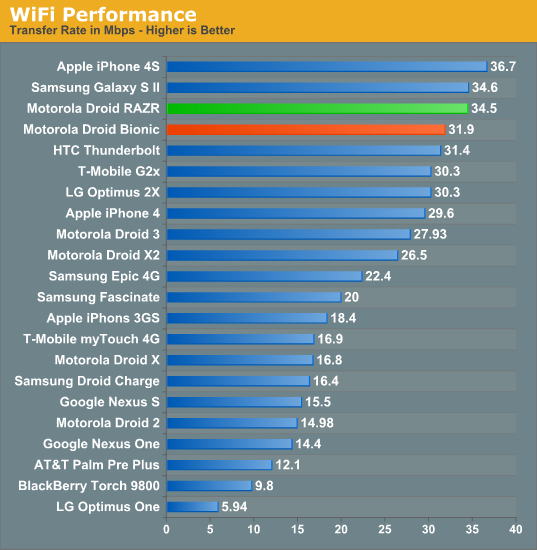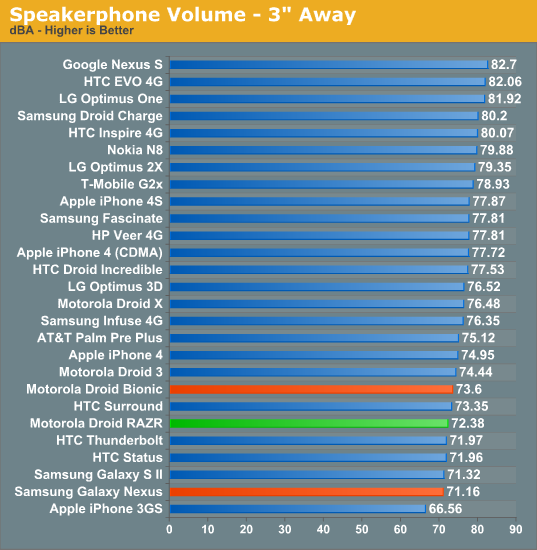Motorola Droid RAZR Review - A Better Clad Bionic
by Brian Klug on December 16, 2011 2:01 AM EST- Posted in
- Smartphones
- Droid
- LTE
- 4G
- Motorola
- Android
- Mobile
- Droid RAZR
- motorola droid RAZR
WiFi, GPS, Audio and Speakerphone
The RAZR uses a TI Wilink 7 series WL1285 combo chip for Bluetooth and WiFi, which is the same situation as the Bionic, unsurprisingly. WiFi is limited to 2.4 GHz and single spatial stream 802.11n, and I saw the RAZR negotiate a 65 Mbps (long guard interval) physical rate with my 20 MHz 802.11n wireless network. I found that range on the RAZR is totally on par with other smartphones I’ve used. Though the visualization at the top seems to be rather conservative with showing bars, if you go view the actual RSSI for WiFi (inside ##4636## and Wireless Information) you’ll see things are just fine. Bluetooth is 4.0 LE + EDR which is the latest bleeding edge.

Throughput on WiFi is pretty decent and just a tad faster than the Bionic. It’s possible the subtle software differences between the two account for this difference in throughput.
WiFi Hotspot
I had some issues with the RAZR’s WiFi hotspot that I didn’t encounter with the Bionic. Specifically, when using the hotspot with WPA2 enabled, clients would only be able to attach occasionally for a short period, or not at all. This initially posed lots of frustration when trying to do our WiFi hotspot battery life test, however disabling encryption entirely and running a public AP resulted in no instability.
You still can attach a maximum of 5 clients if you pay the extra fare to Verizon to enable tethering (which the device does check to see is provisioned), and on the whole this works well, just only with security set to open in my experience.
GPS
To the best of my knowledge, the RAZR is using the GPS system onboard MDM6600 and not from the TI Wilink 7 series combo chip. It’s a bit hard to nail down for sure, but I was able to confirm on the Bionic and it seems reasonable that the same applies here.
Like we’re used to seeing from that system, GPS locks are super fast even indoors and don’t pause or stutter at all. I didn’t have any issues with GPS and used the RAZR a few times with Google navigation without any hitch.
Audio + Speakerphone
First up in the audio department is speakerphone loudness, which we’ve been measuring for a while now using a USB sound level data logger while placing a test call to the local ASOS. The RAZR is on the quiet side which isn’t incredibly surprising considering the placement and constraints on the size of its acoustic chamber.

The other part of audio is of course call quality, and the RAZR isn’t different at all subjectively from the other Motorola phones on Verizon I’ve reviewed recently. As a reminder all calls go over 1x voice, and by default almost every device uses the EVRC coder, though you can change this to 13k in the programming menu and perceive a slight change in call quality. Noise cancellation features likewise remain the same, again courtesy of the three microphones onboard the RAZR.
The last important audio quality metric is what the device sounds like when playing back music. The Bionic used an ST-E 3.1 CPAC combo power management IC and audio codec, and the RAZR uses an ST-E 3.2 CPCAP. I’m embarrassed to admit it, but I only recently discovered how to change (read: disable) the DSP that Motorola has enabled on the RAZR by default (and ostensibly many other of their devices that have crossed my desk). Because I use Google Music, I rarely venture into the first party Music application, and it’s inside here that the settings lurk for DSP, which are by default enabled.
The background whine that I complained about on the Bionic is reduced but still faintly perceptible with sensitive IEMs on the RAZR. Though it is still present, it’s no longer as fatiguing and irritating as it was on the Bionic. I’m not sure whether that’s more a function of ST-E’s 3.2 (as opposed to 3.1) or something else, but it’s much better.
If you’re interested, I also ran a run of RMAA using an ASUS Xonar Xense sound card and line-in on the RAZR, Nexus S with VoodooSound, and a GSM Galaxy Nexus for comparison. The RAZR with all of the equalizer and DSP settings turned off actually isn’t bad at all, and though I’m not an expert at reading RMAA’s tea leaves, it has good noise figures and frequency response, and though noise takes off at the lower frequencies as our own Chris H. pointed out this less than ideal behavior is only 7% of the spectrum.










76 Comments
View All Comments
Devo2007 - Friday, December 16, 2011 - link
Brian Klug - Friday, December 16, 2011 - link
Motorola a few times made specific note that their skin isn't called Blur, even though in build.prop and relevant places, it's called "Blur." I guess it all just boils down to semantics. :)-Brian
yas69 - Friday, December 16, 2011 - link
S2 benchmark values are different with November/December stock firmware.I get 1130 on vellamo with recent S2 firmware. Sunspide/Browsermark values are better than also higher than Razr.
Brian Klug - Saturday, December 17, 2011 - link
What ROM and browser are you tesing in? I can't get any higher than what's in the article on our UK SGS2 with the latest ROM from Kies.-Brian
yas69 - Sunday, December 18, 2011 - link
I9100XWKK2 / I9100XWKL1 both perform better than previous versions.yas69 - Monday, December 19, 2011 - link
sorry.I9100XWKK2 (2.3.6)
Vellamo = 1161
sunspider = 1980
browsermark = 78014
lemmo - Friday, December 16, 2011 - link
Thanks for the review, but do you have any more info on audio quality in terms of music playback? You are saying that it is an improvement over the Bionic but how does it compare to other phones like SGS2 and iPhone?Your detailed review of audio quality on the SGS2 was really helpful and I thought you were going to include this testing methodology on all smartphone reviews from now on...?
kishorshack - Friday, December 16, 2011 - link
Even i expect the same thing brian klug it would be awesome if you update this review someday :)Brian Klug - Saturday, December 17, 2011 - link
We're definitely going to do some more in-depth audio testing, it's something new to me but we've finally got the hardware and methodology, just have to interpret results. I did link to the RMAA runs from here for your own perusal, which we're going to talk a bit more about in the Galaxy Nexus piece.-Brian
lemmo - Saturday, December 17, 2011 - link
Thanks Brian that's great news :)As I asked in my comment below, will you do a comparative audio test with other phones when you do the Nexus review? The test results for just the phone you're testing don't mean much unless we know how they compare. Cheers